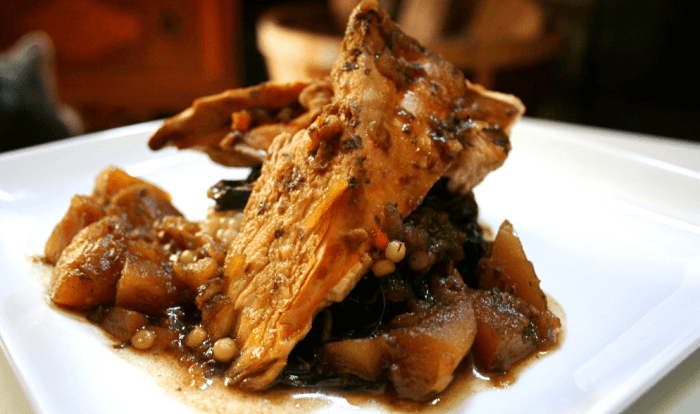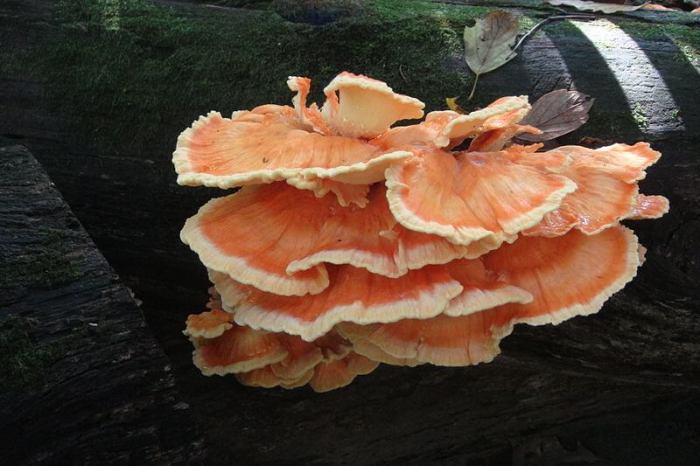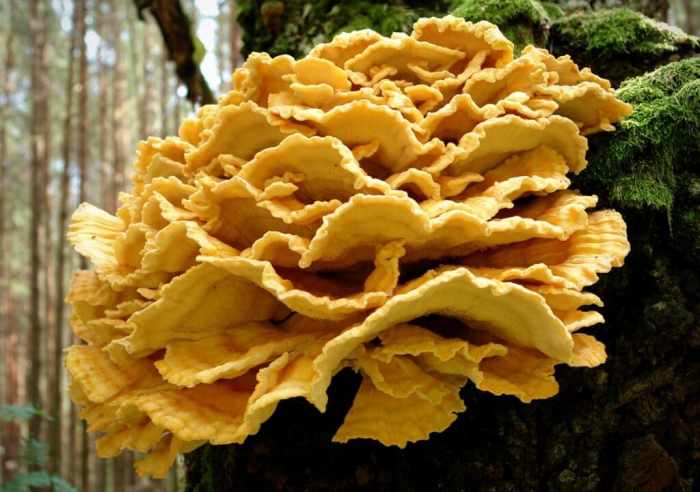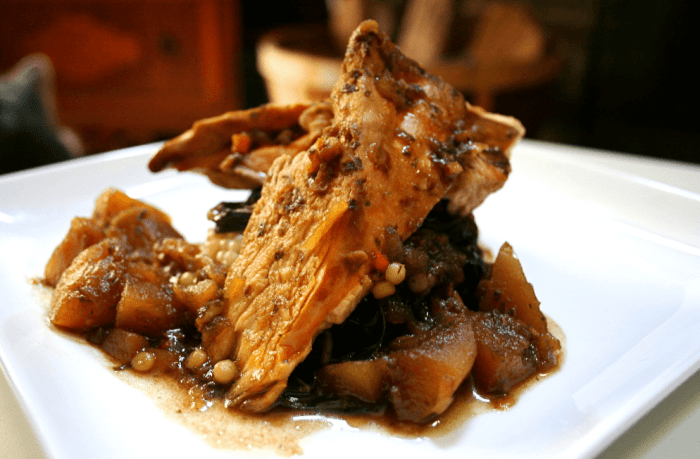
Chicken of the woods recipe – Embark on a culinary adventure with chicken of the woods, a delectable and versatile mushroom that tantalizes taste buds and boasts remarkable medicinal properties. Discover its nutritional prowess, learn how to identify and harvest it safely, and explore a plethora of tantalizing recipes that showcase its culinary versatility.
Chicken of the Woods Nutritional Profile and Health Benefits

Chicken of the woods is a nutrient-rich mushroom with an impressive nutritional profile. It is a good source of protein, fiber, and various vitamins and minerals.One cup of cooked chicken of the woods contains approximately:
- Calories: 120
- Protein: 12 grams
- Fiber: 8 grams
- Vitamin C: 25% of the recommended daily value (DV)
- Potassium: 15% of the DV
- Niacin: 10% of the DV
- Riboflavin: 10% of the DV
- Iron: 8% of the DV
In addition to its nutritional content, chicken of the woods is also known for its potential health benefits. It contains antioxidants and anti-inflammatory compounds that may help protect against chronic diseases such as cancer and heart disease.
Antioxidant Properties
Chicken of the woods contains several antioxidants, including ergothioneine and glutathione. These antioxidants help protect cells from damage caused by free radicals, which are unstable molecules that can contribute to the development of chronic diseases.
Anti-inflammatory Properties
Chicken of the woods also contains anti-inflammatory compounds, such as beta-glucans and polysaccharides. These compounds help reduce inflammation throughout the body, which may benefit conditions such as arthritis and inflammatory bowel disease.
Identifying and Harvesting Chicken of the Woods
Identifying chicken of the woods ( Laetiporus sulphureus) is crucial to ensure safe consumption. It is characterized by its bright orange to yellow color, shelf-like shape, and soft, velvety texture. Unlike true mushrooms, chicken of the woods lacks gills or pores on its underside, which instead features small, tooth-like projections.
Harvesting Chicken of the Woods, Chicken of the woods recipe
Harvesting chicken of the woods should be done responsibly and sustainably. It is best to collect them during their prime growth period, typically in late summer to early fall. Preferred habitats include dead or dying hardwood trees, especially oaks and maples.
When harvesting, use a sharp knife to carefully cut the mushroom from the tree, leaving the base intact to allow for future growth.
Avoiding Look-alikes
Caution is necessary to avoid consuming poisonous look-alikes, such as the toxic Laetiporus sulphureusvar. toxicus. This variety is similar in appearance but has a bitter taste and can cause gastrointestinal distress. Always ensure proper identification before consuming any wild mushrooms.
Preparing Chicken of the Woods for Cooking

To ensure the best culinary experience with chicken of the woods, it’s crucial to properly prepare and preserve the mushroom. This includes cleaning, preservation techniques, and maximizing its flavor and texture during preparation.
Cleaning Chicken of the Woods
- Gently brush off any debris or dirt from the mushroom’s surface.
- Use a sharp knife to remove any tough or woody portions.
- Cut the mushroom into bite-sized pieces or desired shapes for cooking.
Preserving Chicken of the Woods
Chicken of the woods can be preserved for later use through various methods:
- Drying:Slice the mushroom thinly and dehydrate it in a food dehydrator or oven at low temperatures.
- Freezing:Blanch the mushroom briefly in boiling water, then drain and freeze it in airtight containers.
Maximizing Flavor and Texture
To enhance the flavor and texture of chicken of the woods:
- Sautéing:Cook the mushroom in a pan with butter or oil until golden brown.
- Grilling:Grill the mushroom over medium heat until slightly charred and tender.
- Roasting:Roast the mushroom in the oven at high temperatures until caramelized and juicy.
Versatile Culinary Applications of Chicken of the Woods

Chicken of the woods, a versatile culinary delight, offers a diverse range of culinary applications. Its unique flavor and texture make it an excellent ingredient in various cuisines. From sautéing and grilling to roasting and pickling, chicken of the woods shines in numerous cooking methods.
Sautéing and Grilling
Sautéing or grilling chicken of the woods brings out its savory and slightly chewy texture. Cut the mushrooms into bite-sized pieces and toss them with olive oil, salt, and pepper. Cook over medium heat until golden brown and tender. Serve as a side dish or add to salads, sandwiches, or pasta dishes.
Roasting
Roasting chicken of the woods intensifies its earthy flavor. Preheat your oven to 400°F (200°C). Toss the mushrooms with olive oil, herbs, and spices. Roast for 15-20 minutes or until tender and slightly browned. Enjoy as a main course or side dish.
Pickling
Pickling chicken of the woods preserves its unique flavor while adding a tangy twist. Slice the mushrooms and combine them with a mixture of vinegar, sugar, salt, and spices. Let the mushrooms marinate for at least 24 hours before enjoying them as a condiment or side dish.
Complementary Ingredients and Seasonings
Chicken of the woods pairs well with various ingredients and seasonings. Its earthy flavor complements herbs such as thyme, rosemary, and oregano. Garlic, onion, and shallots add a savory depth. Consider adding a touch of citrus, such as lemon or lime juice, to brighten the flavor.
Exploring Medicinal and Traditional Uses of Chicken of the Woods

Chicken of the woods, with its striking appearance and distinct flavor, has held a significant place in traditional medicine for centuries. In various cultures, it has been used to treat a range of ailments, from infections to digestive issues.
I’m all about trying new recipes, especially when they involve unique ingredients like chicken of the woods. If you’re looking for a flavorful and versatile way to prepare this edible fungus, check out this recipe . It’s a great way to experience the earthy and slightly meaty taste of chicken of the woods.
Historical and Cultural Significance
Throughout history, chicken of the woods has been revered for its medicinal properties. In traditional Chinese medicine, it was believed to possess antibacterial and antiviral qualities, and was used to treat conditions like diarrhea and dysentery. In Europe, it was known as “the poor man’s meat” due to its abundance and nutritional value, and was often used as a food source during times of scarcity.
Potential Medicinal Properties
Modern research has shed light on the potential medicinal properties of chicken of the woods. It contains an array of bioactive compounds, including polysaccharides, triterpenes, and phenolics, which have demonstrated various pharmacological effects.
Chicken of the woods is a delicious and versatile mushroom that can be cooked in a variety of ways. If you’re looking for a simple and tasty recipe, try this one . It’s easy to follow and the results are sure to please.
-
-*Antibacterial and Antifungal Activity
Studies have shown that extracts from chicken of the woods exhibit antibacterial and antifungal properties against a range of microorganisms, including Staphylococcus aureus, Escherichia coli, and Candida albicans.
-*Antiviral Activity
Research suggests that chicken of the woods may have antiviral activity against certain viruses, including herpes simplex virus and influenza virus.
-*Anti-inflammatory and Antioxidant Activity
Chicken of the woods contains compounds with anti-inflammatory and antioxidant properties, which may help reduce inflammation and protect cells from oxidative damage.
Anecdotal and Case Studies
Anecdotal evidence and case studies have further supported the medicinal uses of chicken of the woods. Individuals have reported using it to treat conditions such as:
- Skin infections, including athlete’s foot and ringworm
- Respiratory infections, such as bronchitis and pneumonia
- Digestive issues, including diarrhea and indigestion
- Immune system support
While these anecdotal accounts provide insights into the potential medicinal benefits of chicken of the woods, further scientific research is needed to fully understand its efficacy and safety for various conditions.
Outcome Summary

From its nutritional value to its medicinal applications, chicken of the woods emerges as a true culinary and medicinal treasure. Whether you’re a seasoned forager or a curious cook, this guide will equip you with the knowledge and inspiration to fully embrace the wonders of this extraordinary mushroom.
FAQ: Chicken Of The Woods Recipe
What is the best way to cook chicken of the woods?
Chicken of the woods can be sautéed, grilled, roasted, or pickled. It has a meaty texture and a slightly sweet flavor that pairs well with a variety of seasonings and ingredients.
Is chicken of the woods safe to eat?
Yes, chicken of the woods is safe to eat when properly identified and cooked. However, it’s important to note that there are poisonous look-alikes, so it’s crucial to be certain of your identification before consuming it.





